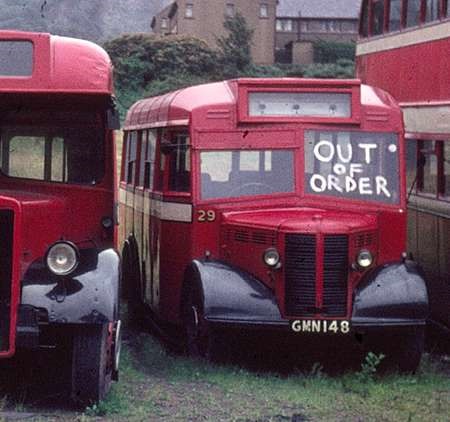London Transport – AEC Merlin – SMM 15F – XMB 15
London Transport Board
1966
AEC Merlin P2R
Strachans B46D
In the mid 1960s London Transport began moving away from its ageing bespoke designs – RT family/ RF/ RM family – and belatedly began investigating the standard offerings of the bus manufacturing industry. The ensuing saga became a sad, expensive story of incompetence, profligacy and waste, from the RC Reliances, XA Atlanteans and MB/SM Merlins/Swifts of the 1960s, and onward through the 1970s and beyond with the Daimler Fleetlines and Metro Scanias. The first London Transport Merlins (Chiswick clung to this appendage even when Southall changed the name of the AH691 engined 36 ft long version to Swift 691) had Strachans dual doorway bodies seating 25 at the rear and accommodating (exceedingly closely – I speak from personal experience) 48 standing passengers in the lower front section. These early examples of the Merlin had a low driving position that was raised on later production models. Classified XMS, fourteen of them equipped with coin operated turnstiles went into service in central London on Red Arrow service 500 in 1966 and performed that duty well. At the same time, the Country Area was pursuing a policy of adopting the Merlin for conventional one man operation as the XMB type, and had nine Strachan B45D bodied examples ready for service in the early months of 1966, but the T&GWU refused to accept them. All except XMB 1 were then repainted red, de-seated to the 25 plus 48 standing format, and used on Red Arrow services. The solitary Country Area survivor, XMB 1, which had 46 seats and then carried the registration JLA 57D, went into store, during which time it was first reclassified as XMB 15 in November 1966, and then re-registered in January 1967 as NHX 15E. In August 1967 its registration was changed yet again to SMM 15F, and it continued to spend time in store with occasional forays out and about for route surveying and training purposes. Finally, in January 1969, nearly three years after delivery, it was transferred to Tring garage where, in the following month, it carried its first fare paying passengers on the single bus allocation route 387 between Tring and Aldbury village. In 1970 it became a member of the London Country fleet, but its identity crisis was still set to continue. In mid 1971 it was reclassified MBS 15 in accordance with the rest of Merlin fleet, but in November 1973 it was sent to the by now GLC controlled London Transport who repainted it red and promptly put it into store. MBS 4, formerly XMB 4 was sent from LT to LCBS in exchange. MBS 15 saw very little, if, indeed any service use with LT thereafter, before being dumped at the old Handley Page airfield at Radlett in 1975 along with very many other unwanted LT Merlins. The following web page illustrates the chequered career of this bus:-
https://ccmv.aecsouthall.co.uk/
In the picture above, taken early in London Country days in 1970 at Tring garage, XMB 15 has lost its London Transport roundel on the front panel, but has yet to receive its LCBS “Flying Wheel” symbol. The Strachans bodies on the early Merlins proved to be of sounder construction than the Metro-Cammell examples on the later deliveries, which quickly showed evidence of structural failure in the roof section above the central doorway.
Photograph and Copy contributed by Roger Cox
10/05/19 – 06:58
Thank you Roger,
Little known about vehicle article and photograph, I just thought these were rather mundane vehicles but did travel on the Red Arrow when they were new. So which one was the model done of ?, possibly a Dinky Supertoy or a Corgi, I did have one, but in my younger days it was repainted to look like an LUT Seddon, that will start the comments flowing, methinks.
Mike Norris
10/05/19 – 07:00
Didn’t quite a lot of these end up being sold to Belfast after being stored at Radlett?
David Pomfret
11/05/19 – 07:00
Several of the Strachan bodied versions along with the regular ones ended up at Gatwick Airport. Gatwick Handling had both types but Bcal and Airtours only had the latter ones. Nearly all replaced by Leyland Nationals.
Keith Hanbury-Chatten
17/05/19 – 06:50
In fairness to LT they were far from alone in having to withdraw MCW Scanias early as they suffered badly from corrosion. The one bought by WYPTE were all withdrawn early for this reason.
Chris Hough
17/05/19 – 10:32
All MetroScanias suffered this fate but, eventually, the Metropolitan had feet of clay. It did not fail as quickly as the MetroScania but in later life there were serious corrosion problems at the back end which some operators addressed by rebuilding them. The reasons for the LT failure with "off the shelf" designs is well documented (here, as elsewhere) – a sad indictment …..
David Oldfield
18/06/19 – 07:49
Surprisingly, when the Docklands Light Railway had a strike last year, 40-year old Metropolitan MD60 turned up on the replacement service. No corrosion apparent. So there’s a bit of life left in the design in London yet.
Bill
19/06/19 – 05:38
Bill, There are very few Metropolitans on the road now, because of the dreaded ‘metal moth’. MD60 is only in circulation thanks to a very lengthy (and no doubt costly) rebuild by the guys at Bus Works Blackpool and owners EnsignBus. See reference to it here: //ensignvintagebuses.blogspot.com
Petras409
26/06/19 – 09:45
Leicester Trust have one on the road as well.
Roger Burdett
17/07/19 – 07:04
Sister vehicle XMS6 (JLA 56D) finished up with The Violet Bus Service at Blackrock, County Louth but none of the Strachans bodied Merlins ended up with Citybus/Ulsterbus in Northern Ireland.
Bill Headley
18/07/20 – 07:18
I travelled on the Red Arrow XMS/MB family types many times in the early ’70’s . Blimey, everything rattled. Whether it was because they were driven with extreme gusto or that the bodywork was moving about I can only guess.
The Strachans JLA-D ones were the worst, the rear of the bus I know now wasn’t attached to the chassis – (is that really right?) which presumably accounted for the rolling and rattling. Still, the fare was only sixpence.
Roger Ingle
18/07/20 – 15:24
Roger I – I have also read that the rear end of the Strachans bodies were not attached to the chassis; and I believe that the same was true of a Daimler Roadliner bodied by East Lancs for Eastbourne Corporation. The thinking was that, with the heavy engine mounted almost at the extreme end of the rear engine, the chassis was inevitably prone to significant vibrations (cantilevering effect). It was anticipated that, over a period of time, this would have the effect of breaking the body structure in the middle, and that the problem would be more severe if the vehicle had a centre door.
The subsequent history tends to suggest that Strachans and East Lancs were correct in their assumptions. Unsurprisingly, the problem was particularly acute with long Daimler Fleetline single deckers, where the engine was mounted transversely, so that all of the weight was concentrated on the rear 3 feet of the chassis. In the mid-1990’s I had occasion to visit an independent operator who had several such Fleetline single deckers (ex-Darlington I think), and we were shown one where the roof above the centre doors had been strengthened at least twice. The effect could justifiably be compared to a camel!
Nigel Frampton
20/07/20 – 06:53
A floating cab was not unknown on half cabs. On breaking the back of rear engined buses. Once drove for a small(ish) coach operator who had four early Scania/Irizars. There were alarmingly evident cracks in the bodywork near the rear axle. Modern Irizars have a good reputation. Maybe they found a solution – but they hadn’t about twenty years ago.
David Oldfield
05/10/21 – 06:24
Thanks for the article and photos. I am making a model using Paragon Kits excellent resin kit so this will be very helpful for the detailing (I shall do it as original all seated with 46 seats).
Gordon Mackley
Quick links to the - Comments Page - Contact Page - Home Page






